|
|
 |
Dive Medicine
|
|
|
| Most
diving accidents or illnesses are related to the effect of
depth/pressure on gases in the body; examples are decompression
sickness, nitrogen narcosis, oxygen toxicity, arterial gas embolism and
CO2 retention. Dysbaric osteonecrosis is an example of the effects on
the bones and joints of bubbles from decreased pressure in a nitrogen
saturated diver. |
|
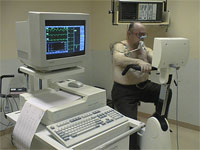
Click
to enlarge
|
Dont's for Divers
- Don't dive into a submerged pool or into the
shallow
end of a pool.
Nine of ten diving injuries occur in six feet of
water or less.
- Don't dive off the side of a diving board--dive
straight ahead
- Don't dive from the edge across the narrow part
of a
pool without
having at least 25 feet of clear dive path in front of you.
- Don't run and dive. That can give you the
same
impact as a dive
from a board
- Don't do a backdive
- Don't try fancy dives or dives with straight
vertical
entry
- Don't dive at or through objects such as inner
tubes
- Don't put diving equipment on a pool that
wasn't
designed for it.
- Don't dive from retaining walls, ladders,
slides, or
other pool equipment.
- Don't dive into unfamiliar bodies of
water.
Remember, 3 of 4
diving accidents happen in natural bodies of water
like lakes and rivers.
- Don't swim and dive alone
- Don't drink and dive. The slowing
effects of
alcohol or drugs on
reaction time can be extremely dangerous in diving.
|
Decompression
Sickness (DCS)
The label
'decompression
sickness' (DCS) was introduced in place of
"Caisson disease". Problems resulting from nitrogen leaving the body
when ambient pressure is lowered i.e. coming up. Decompression sickness
can be classified as either
Type 1 or Type 2.
|
| The
different classification reflects the effect, and
therefore the severity, of the condition. Diagnosing Decompression
sickness as one (or
both) of just two categories does not enable proper identification or
discrimination. However, for the sake of completeness, the two types
are described here. |
|
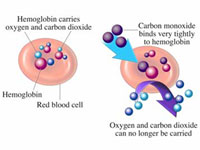 |
|
Type 1 DCS can
occur when
bubbles affect the tissues around skeletal joints. Symptoms usually
include unilateral (on one side of the body) discomfort or pain in one
or more joints. The areas most often affected are the knees, elbows and
shoulders.
Decompression sickness might also present as a skin (cutaneous)
disorder. Nitrogen bubbles can cause mottling, lumps or a rash. "Skin
bends", as they are colloquially termed, are more common during
hyperbaric chamber 'dives' and when diving using a dry suit. Although
not usually in them selves serious, skin symptoms may indicate the
presence of problems elsewhere. A particularly serious cutaneous sign
of DCS is 'cutis marmorata' marbling, in which an area of skin becomes
pale with dark mottling. This is associated with considerable
development of inert gas bubbles within the body.
If left untreated, Type 1 DCS may progress to Type 2.
Type 2
decompression sickness reflects involvement of the Central
Nervous System (CNS) and / or the cardio-respiratory system. More than
half of those diagnosed with DCS will be classified as Type 2.Cerebral
symptoms arise from interruption of the blood supply to the main part
of the brain, and include confusion, reduced mental function and
unconsciousness. Involvement of the cerebellum may lead to tremors,
loss of balance ("staggers") and a lack of co-ordination (ataxia).
Balance may also be affected by damage to the vestibular part of the
inner ear.
Spinal DCS may present as back pain, paresthesia (pins and needles),
paralysis and loss of urinary sphincter control - resulting in either
incontinence or retention.
As discussed already, the formation of small inert gas bubbles does not
necessarily lead to the development of DCS. Likewise, when bubbles
become trapped in the tiny blood vessels around the lungs' alveoli (air
sacs), problems do not always arise. In fact, it is thought that their
accumulation in this area may increase the rate that the gas is
excreted from the body (Edmonds et al, 1993). However, if too many
bubbles collect, breathing will become adversely affected ("chokes").
Symptoms include breathlessness, tachypnoea (increase in breathing
rate), chest pain and coughing. Although symptoms may resolve, this
should be regarded as a life-threatening condition as it may progress
to fatal respiratory collapse.
|
| PFO
(Patent foramen ovale) is a
persistent opening
in the wall of the heart which did not close completely after birth
(opening
required before birth for transfer of oxygenated blood via the
umbilical
cord). This opening can cause a shunt of blood from right to
left , but
more often there is a movement of blood from the left side of the heart
(high pressure) to the right side of the heart (low pressure). |
|
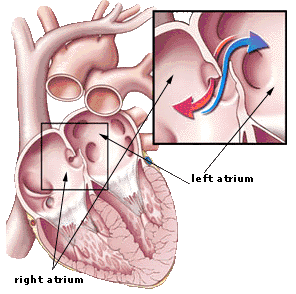 |
People with shunts are less likely to
develop fainting
or low
blood
pressure with diving than are obstructive valve lesions (such as mitral
valve stenosis or aortic stenosis), but are more likely to develop
fluid
accumulation in the lungs from heart failure and severe shortness of
breath
from the effects of combined exercise and water immersion.
Ordinarily, the left to right shunt will cause no
problem; the
right
to left shunt, if large enough, will cause low arterial O2 tension
(hypoxia)
and severely limited exercise capacity. In divers there is the risk of
paradoxical
embolism of gas bubbles (passage of bubbles into
the arterial
circulation) which occur in just about all divers in the venous
circulation
during decompression.
Blood can flow in both directions with Intra-atrial
shunts at
various
phases of the cardiac cycle and some experts feel that a large atrial
septal
defect (PFO) is a contra-indication to diving. In addition, a Valsalva
maneuver, used by most divers to equalize their ears during
descents
and ascents, can increase venous atrial pressure to the point that it
forces
blood containing bubbles across the PFO into the arterial circulation.
Thus
the usual filtering process of the lungs is by-passed. |
Nitrogen narcosis
Nitrogen
narcosis is a
dangerous condition that can affect scuba
divers, especially when diving deeper than 30 meters. The exact
mechanisms behind nitrogen narcosis are still to be explored, but it
has to do with nitrogen gas affecting the nerve transmissions in the
body during high pressure. Since the air inhaled by scuba divers
contains a
large amount of nitrogen (just like the air that we breathe above the
surface every day), nitrogen narcosis was the first type of gas
narcosis experienced by scuba divers, hence the name. The effects of
nitrogen narcosis are similar to the effects of anesthetic gas or
alcohol. It can be hard for the effected diver to realize that he or
she is
developing nitrogen narcosis, since the level of intoxication will
increase gradually. If you suspect that you or your buddy is suffering
from nitrogen
narcosis, you should immediately begin your ascent to shallower depts.
The effects of nitrogen narcosis will usually
wear of as soon as you reach shallower depths, even if they are far
from the surface.
|
Swimmer's Ear
The most common
symptom of outer ear inflammation or infection, known
as swimmer’s ear or otitis externa, is discomfort/pain that may worsen
with pulling on the ear.
|
Occasionally,
outer ear infections can be
caused by a fungal infection. The fungal infection usually occurs on
top of an existing bacterial infection,
often after antibiotic treatment kills off some of the bacteria, which
makes it easier for the fungi to grow. Ear infections can also be
caused by fungi alone, especially in moist, warm climates. .
|
|
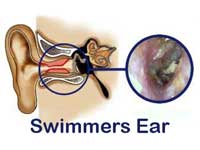 |
Treatment of
swimmer's ear
Swimmer's ear, when
properly treated by a physician, usually clears up
within seven to 10 days. Antiseptic or antibiotic ear drops
should be the front-line treatment
for people suffering from swimmer's ear, while restraint should be
exercised in using oral antibiotics.
Preventing Swimmer's
Ear
Prevention and
treatment of dive-related earache depends upon whether
the cause is in the external auditory canal or middle ear space.
When the problem is within the external ear canal, preventative steps
include the application of drops that protect ear tissue and inhibit
the growth of harmful microorganisms.
Recipe for Homemade
Swimmer's Ear Drops:
- 1 Bottle (I used a condiment bottle purchased
in the
WalMart kitchen aisle for 97¢)
- Label bottle with handy dandy label maker
(optional)
- Place equal parts vinegar & rubbing alcohol
in
bottle
- Give bottle a little shake & turn yourself
about
(again, turning is optional)
- Place a couple drops in each ear after swimming
- That's it - easy peasy!
|
Jellyfish
Jellyfish-related
deaths are rare, but the sting they
inflict is extremely painful. Most known deaths from
jellyfish are attributed to the man-of-war. Other jellyfish can inflict
very painful stings as well. Avoid the long tentacles of any jellyfish,
even those washed up on the beach and apparently dead
Portuguese
man on war
|
|
Although it
resembles a jellyfish, the Portuguese man-of-war is
actually a colony of sea animals. Mainly found in tropical regions, the
Gulf stream current can carry it as far as Europe or Africa. The
Portuguese man-of-war resembles a
large pink or purple balloon floating on the sea.
|
|
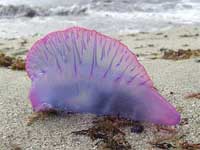 |
The floating portion
of the man-of-war may be
as small as 15 centimeters, but the tentacles can reach 12 meters in
length. The huge tentacles
are actually colonies of stinging cells. These tentacles inflict a
painful and incapacitating sting, but
the sting is rarely fatal.
- Pick off any visible tentacles
with a gloved hand, stick, or anything handy, being careful to avoid
further
injury.
- Rinse the sting thoroughly with
salt or fresh water to remove any adhering tentacles.
- Apply ice for pain control.
- Irrigate exposed eyes with copious
amounts of room temperature tap water for at least 15 minutes. If
vision
blurs, or the eyes continue to tear, hurt, swell, or are light
sensitive
after irrigating, see a doctor.
- For persistent itching or skin
rash, try 1 percent hydrocortisone ointment four times a day, and one
or
two 25 milligram diphenhydramine (Benadryl) tablets every 6 hours.
These
drugs are sold without prescription. Diphenhydramine may cause
drowsiness.
Don't dive, drive, swim or surf after taking this medication.
|
Scorpion Fish
Pain relief is a high
priority in Scorpion fish stings. To ease pain, soak the wound in
non scalding hot water for 30 to 90 minutes. (Victims in pain may
not be able to tell if water is too hot.
|
| Someone
else should test the water temperature on his or her own hand first.)
Heat inactivates at least one of the toxins in the venom, and thus
relieves some of the pain. If pain
returns an hour or more later,
try the heat soaks again. While
soaking, remove any
protruding pieces of the spine or skin from the puncture. |
|
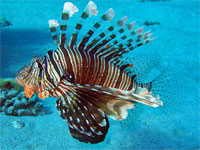 |
Do not
apply a tourniquet, ice, or pressure bandage. To clean the wound,
gently pull the edges of the skin and scrub with clean gauze or a
cloth soaked in clean, fresh water. Victims of infected Scorpion fish stings should see a doctor. If a victim shows any
signs of a serious reaction, consider it a medical emergency.
The public is being asked to capture or kill these fish as they pose a
serious threat to our beautiful Barrier Reef or report any sightings to
the Hol Chan Marine Reserve office.
|
Further reading
This links provide
more Dive Medicine related information.
Scubadoc's Diving
Medicine Online Sitemap
Divers Dan Alert Network Diving
Medicine
To
avoid accidents with Dangerous Creatures, please check out our Danger
Creatures Page. |
|
| Guide to Belize, April 2024
|
|
 |
|
|
|
|
Weather
|
|
GTB Weather
|
 |
Quick News
|
|
|
Site
Search
|
|
|
|
|
|
|
|
|
